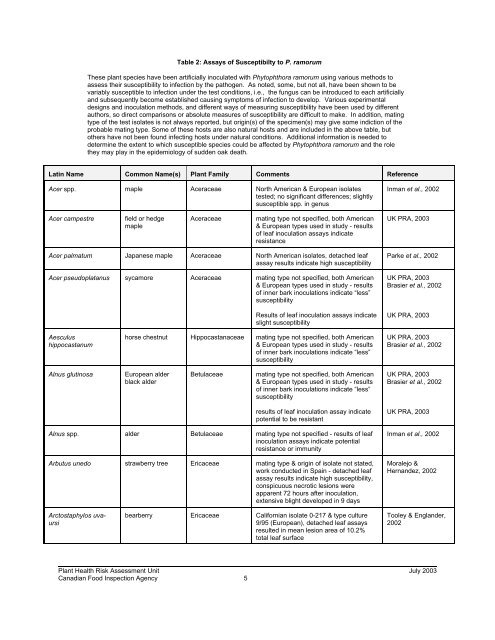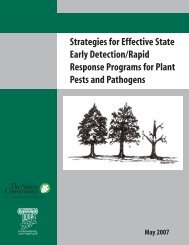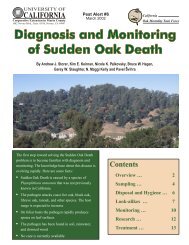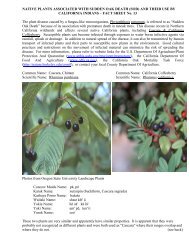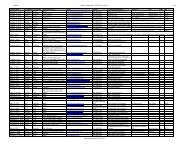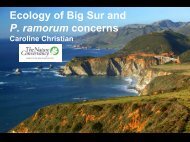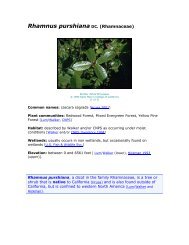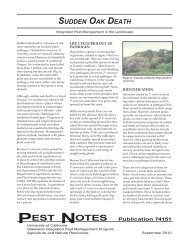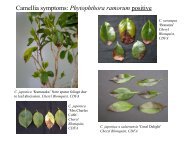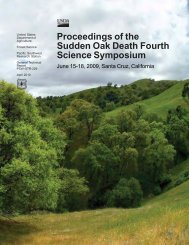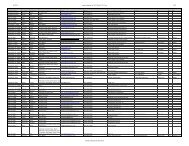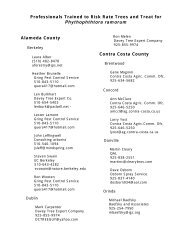Hosts of Phytophthora ramorum, CFIA, July, 2003 - Sudden Oak Death
Hosts of Phytophthora ramorum, CFIA, July, 2003 - Sudden Oak Death
Hosts of Phytophthora ramorum, CFIA, July, 2003 - Sudden Oak Death
Create successful ePaper yourself
Turn your PDF publications into a flip-book with our unique Google optimized e-Paper software.
Table 2: Assays <strong>of</strong> Susceptibilty to P. <strong>ramorum</strong><br />
These plant species have been artificially inoculated with <strong>Phytophthora</strong> <strong>ramorum</strong> using various methods to<br />
assess their susceptibility to infection by the pathogen. As noted, some, but not all, have been shown to be<br />
variably susceptible to infection under the test conditions, i.e., the fungus can be introduced to each artificially<br />
and subsequently become established causing symptoms <strong>of</strong> infection to develop. Various experimental<br />
designs and inoculation methods, and different ways <strong>of</strong> measuring susceptibility have been used by different<br />
authors, so direct comparisons or absolute measures <strong>of</strong> susceptibility are difficult to make. In addition, mating<br />
type <strong>of</strong> the test isolates is not always reported, but origin(s) <strong>of</strong> the specimen(s) may give some indiction <strong>of</strong> the<br />
probable mating type. Some <strong>of</strong> these hosts are also natural hosts and are included in the above table, but<br />
others have not been found infecting hosts under natural conditions. Additional information is needed to<br />
determine the extent to which susceptible species could be affected by <strong>Phytophthora</strong> <strong>ramorum</strong> and the role<br />
they may play in the epidemiology <strong>of</strong> sudden oak death.<br />
Latin Name Common Name(s) Plant Family Comments Reference<br />
Acer spp. maple Aceraceae North American & European isolates<br />
tested; no significant differences; slightly<br />
susceptible spp. in genus<br />
Inman et al., 2002<br />
Acer campestre<br />
field or hedge<br />
maple<br />
Aceraceae<br />
mating type not specified, both American<br />
& European types used in study - results<br />
<strong>of</strong> leaf inoculation assays indicate<br />
resistance<br />
UK PRA, <strong>2003</strong><br />
Acer palmatum Japanese maple Aceraceae North American isolates, detached leaf<br />
assay results indicate high susceptibility<br />
Acer pseudoplatanus sycamore Aceraceae mating type not specified, both American<br />
& European types used in study - results<br />
<strong>of</strong> inner bark inoculations indicate “less”<br />
susceptibility<br />
Results <strong>of</strong> leaf inoculation assays indicate<br />
slight susceptibility<br />
Parke et al., 2002<br />
UK PRA, <strong>2003</strong><br />
Brasier et al., 2002<br />
UK PRA, <strong>2003</strong><br />
Aesculus<br />
hippocastanum<br />
horse chestnut Hippocastanaceae mating type not specified, both American<br />
& European types used in study - results<br />
<strong>of</strong> inner bark inoculations indicate “less”<br />
susceptibility<br />
UK PRA, <strong>2003</strong><br />
Brasier et al., 2002<br />
Alnus glutinosa<br />
European alder<br />
black alder<br />
Betulaceae<br />
mating type not specified, both American<br />
& European types used in study - results<br />
<strong>of</strong> inner bark inoculations indicate “less”<br />
susceptibility<br />
UK PRA, <strong>2003</strong><br />
Brasier et al., 2002<br />
results <strong>of</strong> leaf inoculation assay indicate<br />
potential to be resistant<br />
UK PRA, <strong>2003</strong><br />
Alnus spp. alder Betulaceae mating type not specified - results <strong>of</strong> leaf<br />
inoculation assays indicate potential<br />
resistance or immunity<br />
Arbutus unedo strawberry tree Ericaceae mating type & origin <strong>of</strong> isolate not stated,<br />
work conducted in Spain - detached leaf<br />
assay results indicate high susceptibility,<br />
conspicuous necrotic lesions were<br />
apparent 72 hours after inoculation,<br />
extensive blight developed in 9 days<br />
Inman et al., 2002<br />
Moralejo &<br />
Hernandez, 2002<br />
Arctostaphylos uvaursi<br />
bearberry Ericaceae Californian isolate 0-217 & type culture<br />
9/95 (European), detached leaf assays<br />
resulted in mean lesion area <strong>of</strong> 10.2%<br />
total leaf surface<br />
Tooley & Englander,<br />
2002<br />
Plant Health Risk Assessment Unit <strong>July</strong> <strong>2003</strong><br />
Canadian Food Inspection Agency 5


